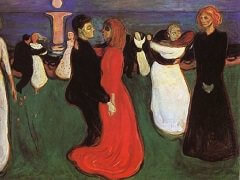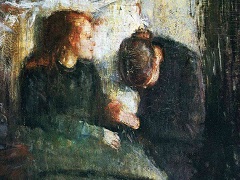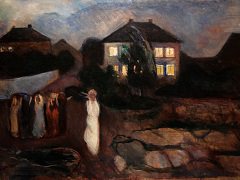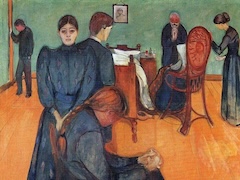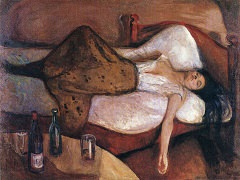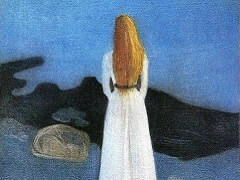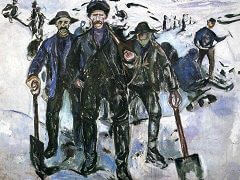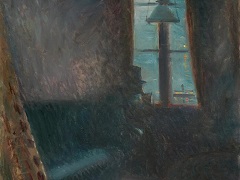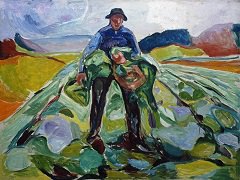Jealousy, 1895 by Edvard Munch

This painting brings together the Adam and Eve theme with the portrayal of Stainislaw Przybyszewski - Munch's Polish poet fried, with his prominent bearded features.
Przybyszewski's likeness in Jealousy has often been lined to Munch's presumably amorous relationship with the poet's wife, Dagny Juell, whom he painted in 1893 - the year of her marriage. the charged triangular situation, which in various degrees of recognizability reveals the features of the same protagonists, is also reflected in an oil of 1913 at the Munch-museet and in other related versions, among them Passion. Thus passion, jealousy, the biblical allegory of temptation, and an autobiographical incident converge in Munch's work, recurring in paintings and prints at different times.
The small Bergen oil is firmly structured and the definition of the picture planes is exceptionally clear. Przybyszewski occupies the extreme foreground, tree and door share the middle plane, and the quasi-biblical occurrence recedes into the distant picture space.
Munch here preserves the anonymity of the situation by lending recognizable features to Przybyszewski only. Eve, partly covered by a scarlet garments, exposes a naked front - much in the way of the central figure in the various versions of Woman in three Stages. She is pictured as she picks the fateful apple - an act translatable to the jealous mind of the brooding foreground figures as apprehension in flagrante delicto. Przybyszewski's colorless features are in effective contrast with the sensuous redness of Eve's face and flowing garment - a redness that in turn is echoed by the sinful apple and the potted plant posted before the door of Eden. Adam appears in modern dress. The deviation from biblical nudity serves, of course, to restate the old theme in a contemporary context. Whether intended or not, the clad and veiled bodies of the original sinners also suggest that their innocence had been impaired even before the modern reenactment of the fateful deed. A sinuous pattern envelops the work within a formal unity that comprises thinker and thought, dream and reality, lining Jealousy to the style of the 1890 known by such names as Art Nouveau and Jugendstil.



